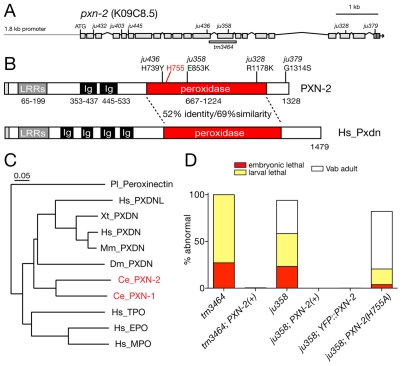Fig. 1.
pxn-2 encodes a C. elegans peroxidasin that is required for body morphogenesis. (A) Genomic structure of pxn-2, showing locations of point mutations and the tm3464 deletion. (B) Domain organization of PXN-2 and human (Hs) peroxidasin. (C) C. elegans PXN-2 and PXN-1 are most closely related to Drosophila and vertebrate peroxidasins, and more distantly related to other myeloperoxidases. Neighbor-joining tree based on ClustalW alignment of peroxidase domains. Ce, C. elegans; Dm, Drosophila melanogaster; Pl, Pacifastacus leniusculus (crayfish); Xt, Xenopus tropicalis; Mm, Mus musculus; Hs, Homo sapiens. Humans have two peroxidasin-encoding genes, PXDN and PXDNL; however, phylogenetic analysis indicates that the two C. elegans peroxidasins diverged separately and are not orthologous to the vertebrate gene pairs. (D) Morphological and lethal phenotypes of pxn-2(tm3464) and pxn-2(ju358) are completely rescued by transgenes containing a pxn-2 cDNA under the control of a 1.8 kb pxn-2 promoter [PXN-2(+), juEx2140] and by the YFP::PXN-2 transgene (juEx2492). Rescue activity of PXN-2(H755A) transgenes (juEx2491) was significantly reduced compared with that of PXN-2(+). Vab, variably abnormal epidermal morphology phenotype.

